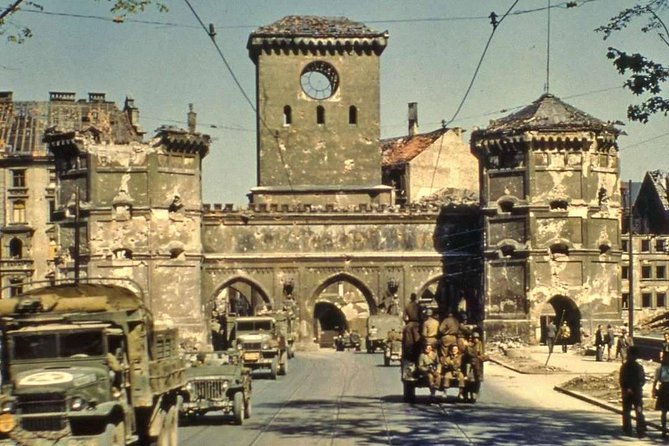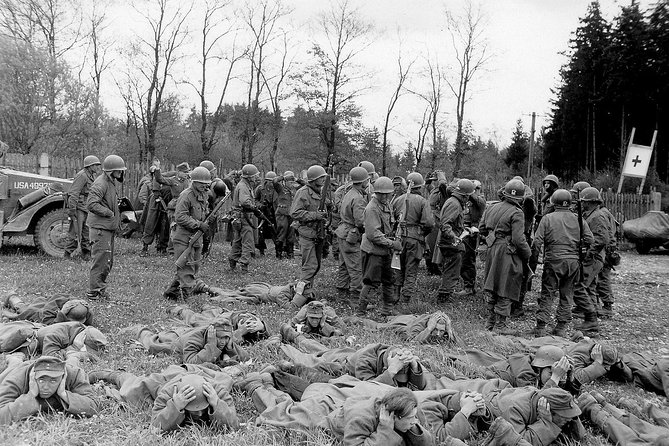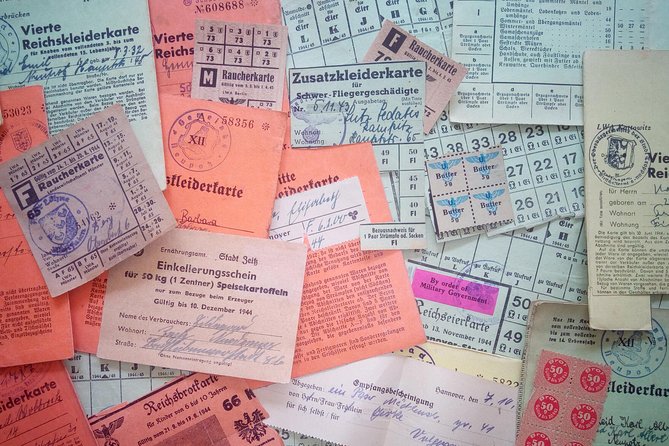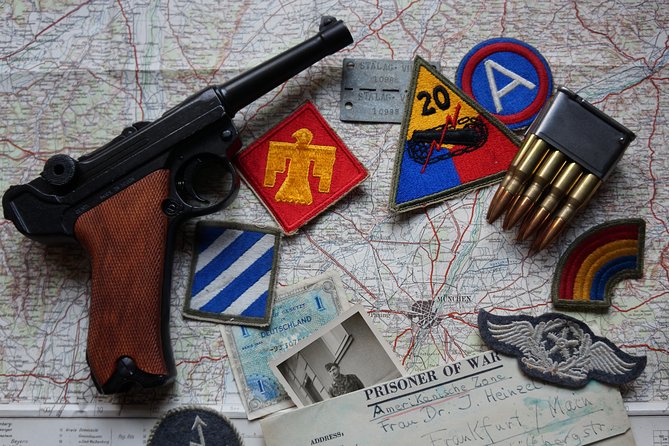Munich’s tumultuous history during the Nazi era and World War II offers a captivating glimpse into a complex and pivotal period. This private walking tour guides visitors through the city’s transformation, exploring key sites that witnessed the rise and fall of the Third Reich. From the former Nazi party headquarters to the Odeonsplatz, where mass rallies echoed the party’s ideology, the tour provides in-depth insights into the resistance efforts and the aftermath that forever shaped Munich’s identity. Delving into this significant chapter of history, the tour invites participants to uncover the city’s past and consider its lasting impact.
This experience made our list of the 20 Best Private Tours In Munich.
Key Points

- Explore the historic sites of the Nazi Party’s origins and activities, including the former party headquarters and rally grounds in Munich.
- Learn about the resistance efforts against the Nazi regime, such as the actions of the White Rose student group.
- Understand the role of Munich as a stronghold for the Nazi party, hosting annual rallies and bearing witness to Kristallnacht.
- Discover the challenges of post-war reconstruction and denazification efforts in the city.
- Gain insight into the importance of historical preservation and education to confront the complex legacy of the Nazi era.
Origins of the Nazi Party in Munich

Munich served as the birthplace of the Nazi Party, with Adolf Hitler and other early party leaders establishing their headquarters in the city during the 1920s.
The party’s origins can be traced back to a small political group known as the German Workers’ Party, which was founded in Munich in 1919 and eventually evolved into the more extreme and nationalistic Nazi Party under Hitler’s leadership.
From this base, the Nazis began their rise to power, capitalizing on the economic and political turmoil of the post-World War I period to gain support among the German people.
Munich’s central role in the party’s formative years made it a key battleground in the struggle for control of Germany.
You can also read our reviews of more walking tours in Munich
Key Sites of the Nazi Regime

Several iconic Nazi party sites dot the city’s landscape, showcasing the regime’s grip on Munich during its rise to power. These landmarks include the former Nazi party headquarters, the Führerbau, where Hitler and other top officials held meetings, as well as the historic Odeonsplatz, the site of many early Nazi rallies and demonstrations.
The Brown House, the former headquarters of the Nazi Party.
The Königsplatz, the location of the Nazi Party Rally Grounds.
The Feldherrnhalle, where a failed coup attempt by the Nazis took place in 1923.
The Königlicher Platz, the location of the Nazi Party’s first permanent headquarters.
These sites provide a sobering glimpse into Munich’s dark past and the rise of the Nazi regime.
The Odeonsplatz and Nazi Gatherings
At the Odeonsplatz, the Nazis frequently held mass rallies and demonstrations, capitalizing on the square’s central location and symbolic significance to showcase their growing power and ideology.
This historic site, with its imposing architecture, was a prime venue for the Nazi Party to gather crowds and deliver rousing speeches.
The Odeonsplatz witnessed some of the most infamous Nazi gatherings, including the annual Führersweihe ceremony, where Hitler would ceremonially bless the party’s flags and standards.
Through these events, the Nazis aimed to indoctrinate the public, cultivate a sense of unity, and solidify their control over Munich – a city that played a crucial role in the rise of the Third Reich.
Resistance to the Nazi Regime
Despite the Nazis’ firm grip on power in Munich, pockets of resistance emerged throughout the city, as individuals and groups took courageous stands against the regime’s oppression and totalitarian policies.
Among them were:
-
The White Rose student resistance group, who distributed anti-Nazi leaflets and were executed for their efforts.
-
Catholic clergy who criticized the regime’s policies from the pulpit, often facing harassment and imprisonment.
-
Workers who engaged in strikes and slowdowns to protest Nazi labor policies and economic controls.
-
Ordinary citizens who helped hide and protect Jews and other targeted groups, risking severe punishment if caught.
While small in number, these brave resisters demonstrated the power of moral conviction in the face of tyranny.
Munich Under Nazi Rule
With the courageous but limited resistance efforts unable to halt the Nazis’ ascent to power, Munich became a stronghold for the party and a key center of its activities in the 1930s.
The city hosted the annual Nazi party rallies and served as the site of the party’s headquarters. Major buildings like the Brown House and Führerbau were constructed to assert the Nazis’ dominance.
Munich’s residents witnessed the Kristallnacht pogrom in 1938 and the city’s synagogues were destroyed.
As World War II began, Munich was subjected to Allied bombing raids, though it avoided the worst of the war’s devastation.
The tour explores these and other aspects of Munich’s tumultuous Nazi past, providing an illuminating look at a dark chapter in the city’s history.
You can also read our reviews of more private tours in Munich
- Neuschwanstein Castle Skip-the-Line Private Tour for Groups
- Neuschwanstein & Linderhof Castle Private Day Tour From Munich
- Munich in the 3rd Reich and WW2 Private Walking Tour
- Munich Private Custom Walking Tour With a Local
- Neuschwanstein Castle, Linderhof, Ettal, Oberammergau Private Tour From Munich
- Neuschwanstein Castle and Linderhof Private Tour From Munich
The Aftermath of World War II
The war’s end brought significant changes to Munich, as the city grappled with the aftermath of its Nazi past. Allied forces occupied the city, and residents faced the daunting task of rebuilding and reconciling with the atrocities committed under Nazi rule. Denazification efforts sought to remove former Nazi officials from positions of power, while Munich’s citizens confronted the physical and emotional devastation left by the war.
The reconstruction process was arduous, with the city’s infrastructure and housing in ruins. However, Munich’s resilience shone through as it worked to:
- Rebuild damaged buildings and landmarks
- Provide housing and support for displaced residents
- Establish new democratic institutions and governance
- Foster reconciliation and promote healing within the community
Significance of Historical Preservation

As Munich worked to rebuild and reconcile after the war, the significance of historical preservation became increasingly apparent. Safeguarding the city’s landmarks and artifacts was crucial for maintaining a connection to its past and promoting understanding among its people.
The guided walking tour through sites linked to the Nazi era allowed visitors to grapple with Munich’s complex history, fostering greater awareness and reflection. By preserving these historic places, the city could confront its past, honor the victims, and educate future generations.
This commitment to historical preservation wasn’t just about the past, but about using it to shape a more just, inclusive future for Munich and its people.
Personalized Guided Tour Experience

Though the walking tour covers significant historical sites, it provides a personalized experience tailored to visitors’ interests.
The private guide engages participants by offering in-depth explanations and encouraging discussion, fostering a deeper understanding of Munich’s complex past during the Nazi era and World War II.
This customized approach allows the tour to cater to a range of backgrounds and preferences:
- Visitors can ask questions and explore topics that interest them most, ensuring a truly engaging and meaningful experience.
- The guide’s expertise and flexibility allow them to adjust the pace and focus of the tour based on participants’ needs and curiosity.
- The small-group setting promotes a more intimate and interactive dynamic, facilitating open dialogue and a heightened sense of connection with the material.
Personalized recommendations for further exploration of Munich’s history can be provided at the end of the tour.
Frequently Asked Questions
What Type of Transportation Is Included in the Tour?
The tour does not include any transportation. It is a private walking tour, so participants are expected to explore the city on foot during the duration of the experience.
Can the Tour Be Customized for Specific Interests?
The tour can be customized to accommodate specific interests. Guests can discuss their preferences with the private guide, who can tailor the experience to focus on areas of particular interest during the walking tour.
What Are the Weather Contingency Plans?
The tour operates in all weather conditions. The private guide will adjust the tour route and activities as needed to account for any inclement weather, ensuring guests remain comfortable throughout the experience.
Are There Any Discounts or Special Offers Available?
The tour doesn’t offer any discounts or special offers. However, it does provide a full refund if canceled at least 24 hours before the tour, making it a flexible booking option for guests.
Can the Tour Be Booked for a Group or Private Party?
The tour can be booked for a group or private party. The walking tour offers a personalized experience with a private guide, allowing for a tailored tour for individuals or small groups.
Recap
The Munich in the 3rd Reich and WWII private walking tour offers an immersive exploration of the city’s pivotal role during a dark chapter in history.
Visitors can explore the complex legacy of the Nazi regime, resistance efforts, and the aftermath, fostering a deeper understanding of this significant period.
The personalized guided experience provides invaluable insights, ensuring a thoughtful and impactful journey through Munich’s past.
More Walking Tours in Munich
More Tours in Munich
- Dachau Memorial Public Tour
- Private Tour from Munich to Eagle’s Nest and Salzburg
- Neuschwanstein and Linderhof Castle Private Tour from Munich
- Half Day Private Tour Linderhof Castle & Oberammergau incl Ettal
- From Munich: Neuschwanstein & Linderhof Castle Day Tour Private 8 Pax
- Traditional Bavarian Coffee and Cake private Tour in Munich
More Tour Reviews in Munich
- Dachau Memorial Public Tour
- Private day trip from Munich to Salzburg, Hallstatt & back
- Private Tour from Munich to Eagle’s Nest and Salzburg
- Airport Transfer: Munich Airport MUC to Munich by Business Car
- Neuschwanstein and Linderhof Castle Private Tour from Munich
- Explore Munichs History and Culture with a Local
Not for you? Here's more nearby things to do in Munich we have reviewed
- Dachau Memorial Public Tour
- Private day trip from Munich to Salzburg, Hallstatt & back
- Private Tour from Munich to Eagle’s Nest and Salzburg
- Airport Transfer: Munich Airport MUC to Munich by Business Car
- Neuschwanstein and Linderhof Castle Private Tour from Munich
- Explore Munichs History and Culture with a Local
- Half Day Private Tour Linderhof Castle & Oberammergau incl Ettal
- From Munich: Neuschwanstein & Linderhof Castle Day Tour Private 8 Pax
- Munich Photoshoot: A Must-Have Holiday Experience!
- Traditional Bavarian Coffee and Cake private Tour in Munich
- Private Transfer from Munich to Prague with 2 hours of Sightseeing, local driver
- From Munich to Nuremberg Day Trip
